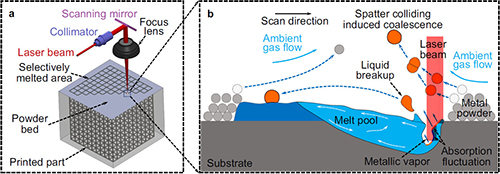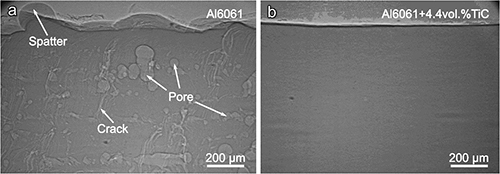
A process known as laser powder bed fusion (LPBF) can produce complex three-dimensional (3-D) metallic parts that are often difficult or impractical to produce using conventional manufacturing techniques. The LPBF process shares some similarities with hobbyist 3-D printers, where plastic objects are gradually built-up one thin layer atop another. However, while consumer 3-D printers create objects from a relatively low-melting-point thermopolymer, LPBF employs a high-intensity laser beam to quickly melt selected areas of a metallic powder at high temperatures. This extremely rapid melting of the metallic powder typically produces large, unwanted spatters that can contaminate the final 3-D-printed part. Now researchers have demonstrated that adding titanium carbide (TiC) nanoparticles to aluminum powders can fully eliminate large spatter formation. To uncover how the nanoparticles improved the LPBF process, an x-ray video of the printing process was captured at the U.S. Department of Energy’s Advanced Photon Source (APS). These findings, published in Nature Communications, constitute a major step towards improving LPBF-based 3-D printing and its widespread adoption by industry. Adding nanoparticles may also enhance other metal manufacturing processes, such as better welded and cast components.
Intricate metal parts with convoluted tubes, recesses, cavities, and similar features can be time-consuming and expensive to produce using conventional machining techniques. This is because conventional methods typically require specialized tooling and the creation of multiple components, which are then assembled into the final product. In contrast, LPBF allows manufacturers to create complete metal parts in a single go, without the need for expensive tooling. During LPBF printing, a computer guides a laser beam over a bed of metallic powder, fusing it into a pre-designated pattern (Fig. 1a). Then a new powder layer is laid down and the laser builds up another incremental section atop the previous one. This iterative process continues until the desired object emerges.
LPBF not only produces complex parts quickly, but the end-product should theoretically be stronger since it consists of a homogeneous object instead of multiple components joined together All these benefits make LPBF appealing to the biomedical, aerospace, military, and automotive industries. In practice, however, LPBF-produced parts often exhibit serious structural defects, like cracks and pores, that compromise their strength and durability.
Large metallic globules, called spatters, that arise during powder fusion are the principal cause of the structural defects (Fig. 1b). Eliminating these large spatters has proven very difficult because their generation is intrinsic to the laser-powder-bed interaction instabilities. These instabilities arise from the action of the powerful laser used in LPBF, which almost instantly transforms solid powder into the liquid and vapor phases.
The liquefied powder forms a boiling melt pool, from which a strong vapor jet emerges (bottom right of Fig. 1b). The recoil pressure from the vapor jet pushes the metallic liquid down and outwards to generate a highly fluctuating vapor depression, resulting in a continuous spray of ejected droplets from the melt pool. Additionally, the vapor jet sucks up many of the spatters ejected from the melt pool, which often collide to form larger spatters. Collectively, the ejection-induced large spatters and the colliding-induced large spatters significantly degrade the LPBF process and overall product quality.
To address these problems, the researchers investigated whether adding nanoparticles might help. An aluminum powder (Al6061) was mixed with a small proportion of titanium carbide (TiC) nanoparticles (4.4% TiC nanoparticles by volume). A thin layer of this nanoparticle-enriched powder was laid down in an experimental LPBF apparatus. As the LPBF laser melted the powder, a high-speed, high-resolution x-ray “movie” recorded the process at the X-ray Science Division Imaging Group’s 32-ID-B beamline, thanks to the extreme brightness of x-rays from the APS, an Office of Science user facility at Argonne National Laboratory. A similar experiment was recorded using Al6061 powder without nanoparticles.
The x-ray imaging revealed that roughly 3,000 large spatters formed every second during 3-D printing with the nanoparticle-free powder. Incredibly, no large spatters formed when the nanoparticle-rich powder was used. The smaller spatters were prevented from merging into larger ones because the nanoparticles formed a resilient “skin” on their surface. The nanoparticles also stabilized the vapor depression by increasing melt pool viscosity, which eliminated the large spatters ejected from the melt pool.

The printed part created from the nanoparticle-enriched powder was far lower in defects than the printed part made from the nanoparticle-free powder (Fig. 2). The nanoparticle-rich parts also exhibited much finer grain structure, far higher surface smoothness, and a very high tensile strength.
Further research should provide a deeper understanding of the mechanisms behind nanoparticle-enhanced LPBF printing, and aid in the rational design of nanoparticles for other alloy systems. ― Philip Koth
See: Minglei Qu, Qilin Guo, Luis I. Escano, Ali Nabaa, S. Mohammad H. Hojjatzadeh, Zachary A. Young, and Lianyi Chen*, “Controlling process instability for defect lean metal additive manufacturing,” Nat. Commun. 13, 1079 (2022). DOI: 10.1038/s41467-022-28649-2
Author affiliation: University of Wisconsin-Madison
Correspondence: * [email protected]
The researchers would like to thank beamline scientists Kamel Fezzaa, Tao Sun, and Chihpin Andrew Chuang at the APS for their help on the beamline experiments. The authors acknowledge use of facilities and instrumentation at the UWMadison Wisconsin Centers for Nanoscale Technology (wcnt.wisc.edu) partially supported by the NSF through the University of Wisconsin Materials Research Science and Engineering Center (DMR-1720415). This work is supported by National Science Foundation (Award No. 2002840, L.C.) and the University of Wisconsin- Madison Startup Fund (L.C.). This research used resources of the Advanced Photon Source, a U.S. Department of Energy (DOE) Office of Science user facility operated for the U.S. DOE Office of Science by Argonne National Laboratory.
The U.S. Department of Energy's APS at Argonne National Laboratory is one of the world’s most productive x-ray light source facilities. Each year, the APS provides high-brightness x-ray beams to a diverse community of more than 5,000 researchers in materials science, chemistry, condensed matter physics, the life and environmental sciences, and applied research. Researchers using the APS produce over 2,000 publications each year detailing impactful discoveries, and solve more vital biological protein structures than users of any other x-ray light source research facility. APS x-rays are ideally suited for explorations of materials and biological structures; elemental distribution; chemical, magnetic, electronic states; and a wide range of technologically important engineering systems from batteries to fuel injector sprays, all of which are the foundations of our nation’s economic, technological, and physical well-being.
Argonne National Laboratory seeks solutions to pressing national problems in science and technology. The nation's first national laboratory, Argonne conducts leading-edge basic and applied scientific research in virtually every scientific discipline. Argonne researchers work closely with researchers from hundreds of companies, universities, and federal, state and municipal agencies to help them solve their specific problems, advance America's scientific leadership and prepare the nation for a better future. With employees from more than 60 nations, Argonne is managed by UChicago Argonne, LLC, for the U.S. DOE Office of Science.
The U.S. Department of Energy's Office of Science is the single largest supporter of basic research in the physical sciences in the United States and is working to address some of the most pressing challenges of our time. For more information, visit the Office of Science website.
